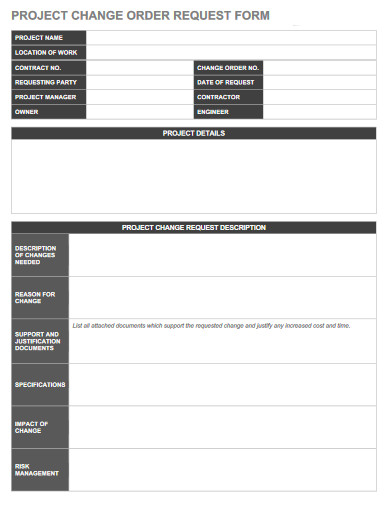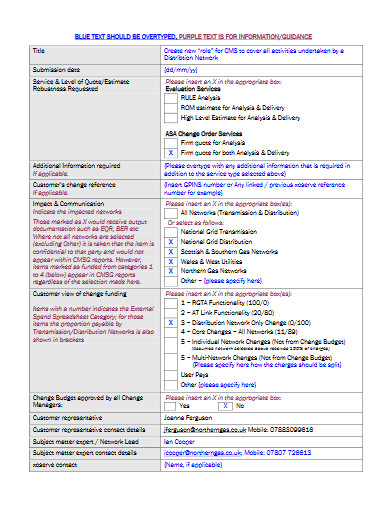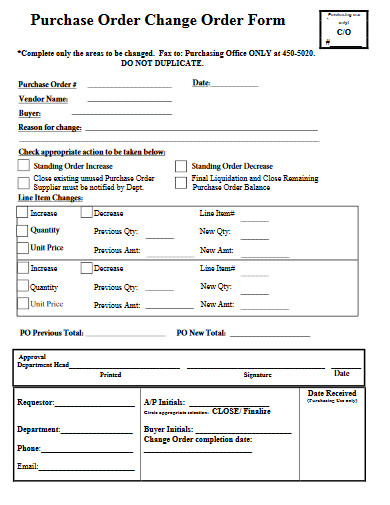10+ Change Order Form Examples to Download
As the old saying goes, change is the only permanent thing in the world. It rings true, especially for contractors and the bank industry. Change is an unavoidable part of the building process. That’s why if it’s not managed carefully, it can lead to several issues that will wreak havoc on your bottom line.
The number of changes incurred can directly affect the project’s profitability and level of risk. If you don’t want such a thing to happen, the following are samples and steps to create an order request.
10+ Change Order Form Examples
1. Construction Change Order Form Template

2. Project Change Order Request Form
3. Change Order Form Example
4. Change Order Form Example
5. Contractor Change Order Form
6. Project Change Order Form
7. Purchase Order Change Order Form
8. Construction Change Order Form in PDF
9. Change Order Request Form
10. Swimming Pool Change Order Request Form
11. Change Order Verification Form
What Is a Change Order Form?
A change order form is a document that details modifications to the scope of construction, site conditions, designs, and even the project timetable. In all cases, the change order process dictates the construction contract. However, don’t forget to provide specific guidelines on how to coordinate and process the change order. It would affect not only the project scope and timetable but also the budget. Therefore, it’s necessary to know how to create a change order form.
How To Create a Change Order Form?
A change order modifies you and your contractor’s original building plans. Some examples of circumstances that can lead to change orders are; soil issues, building conditions, and design updates. Do you have any idea what format you would write? If not, make use of the following.
Here are a few steps on how to create a change order form:
Step 1: Start With the Original Contract
Initially, a change order won’t exist without an original contract. Otherwise, you would have nothing against which to make modifications. In a legal sense, change orders make you, the contractor, and the owner accountable. If there are changes in jobsite terms, regulatory and safety matters, or material substitutions, change orders are necessary.
Step 2: Analyze the Blueprints and Specifications
When you fail to address, clarify, and review issues with the project’s scope, you will have many things to do later. For sure, no one would like such a thing to happen. Therefore, it’s necessary to review and anticipate the current status and conditions to ensure that no potential issues will arise. If there are ambiguous erros and drawings in the scope, it can result in labor and material shortages for the project. The failure in identifying problems with the range of work and plans will lead to unnecessary changes later in the project.
Step 3: Don’t Delay or Ignore Change Orders
The owner or the contractor is the one who usually requests a change order. It’s vital to deal with it as soon as possible. Negotiate the cost, obtain written permission to begin the work, and make schedule changes for the amended work to accomplish this. Delaying change orders can be devastating for a project and lead to significant cost overruns and an incorrect schedule.
Step 4: Communicate With All Individuals Involved
Part of the change of order is to speak with all parties included in the project. As a manager or head, make sure to keep your contact with subcontractors, owners, and other owner’s authorized agents. Ask them to define a new scope and come to an agreement on change order expectations. Subcontractors need effective communication, especially during the change order process. It’s because they need to adjust their schedules and talk about the possible effect on their job.
FAQs:
What’s a change order request?
A change order is an adjustment to the original construction plans agreed upon by you and your contractor. Its purpose is to create a record of additional services. Once a contractor fails to use change orders, the company may lose out on getting paid on such added assistance.
What’s the difference between a change order and a variance order?
A variant is a different kind of variation from an agreed-upon, well-defined schedule or scope of works. However, a change order is a formal document used to amend a contractual agreement and incorporated in the project documents.
What’s a change order in banking?
A change order is a written document that details and specifies changes to a building plan. It is a modification to the original building contract. A contract can initiate a change order by one of the contracting parties. However, that’s when both of them agreed to the terms. That makes the order valid.
During building projects, both individuals and company owners ay deal with challenges that involve construction. As a result, you need to educate yourself about the dos and don’ts during the process. Having enough knowledge about the information above can save you a lot in the end. As you become more procedure-oriented, a successful change order process can assist your customer relationships, make your company seem more professional, and add to your bottom line as you become more procedure-oriented.












